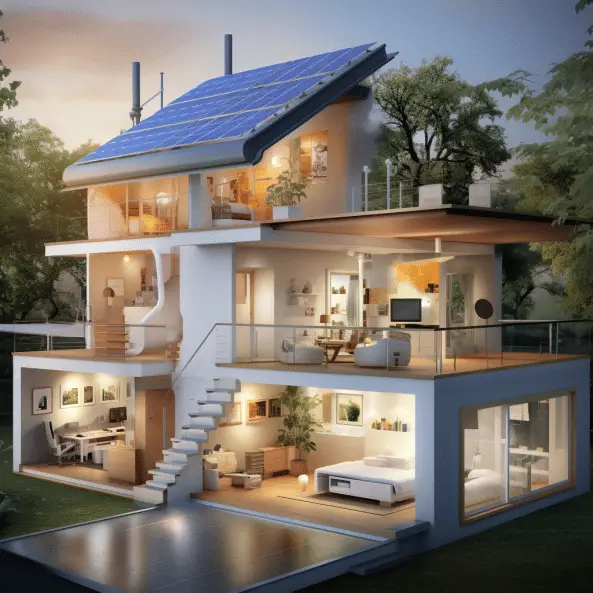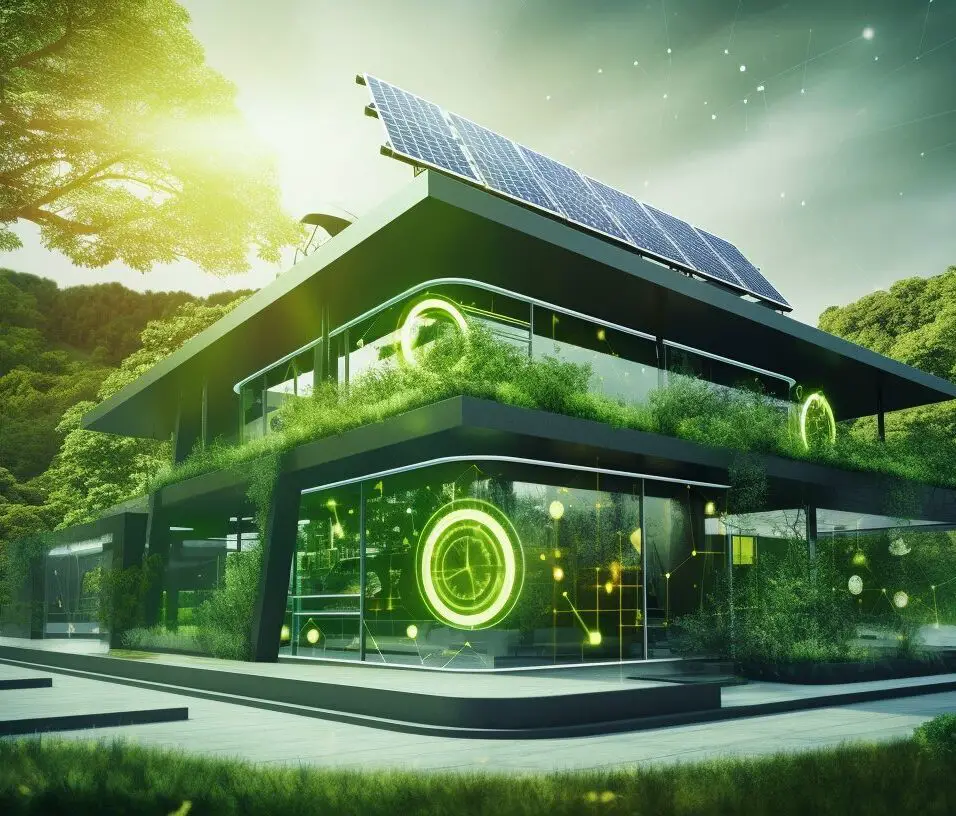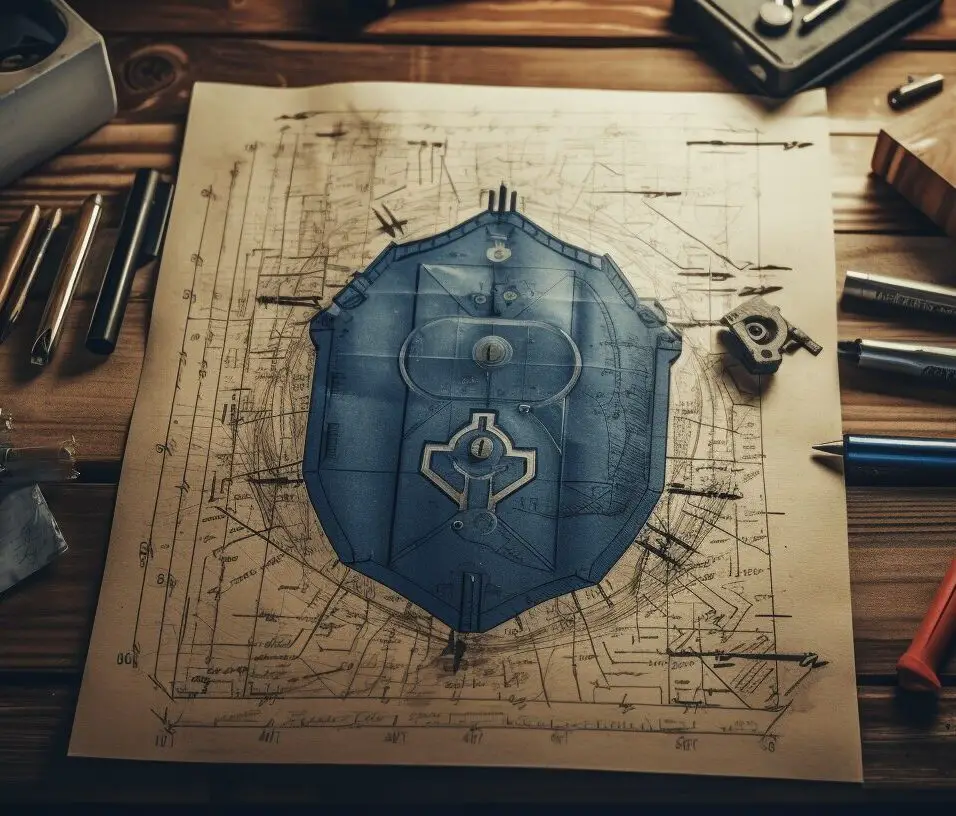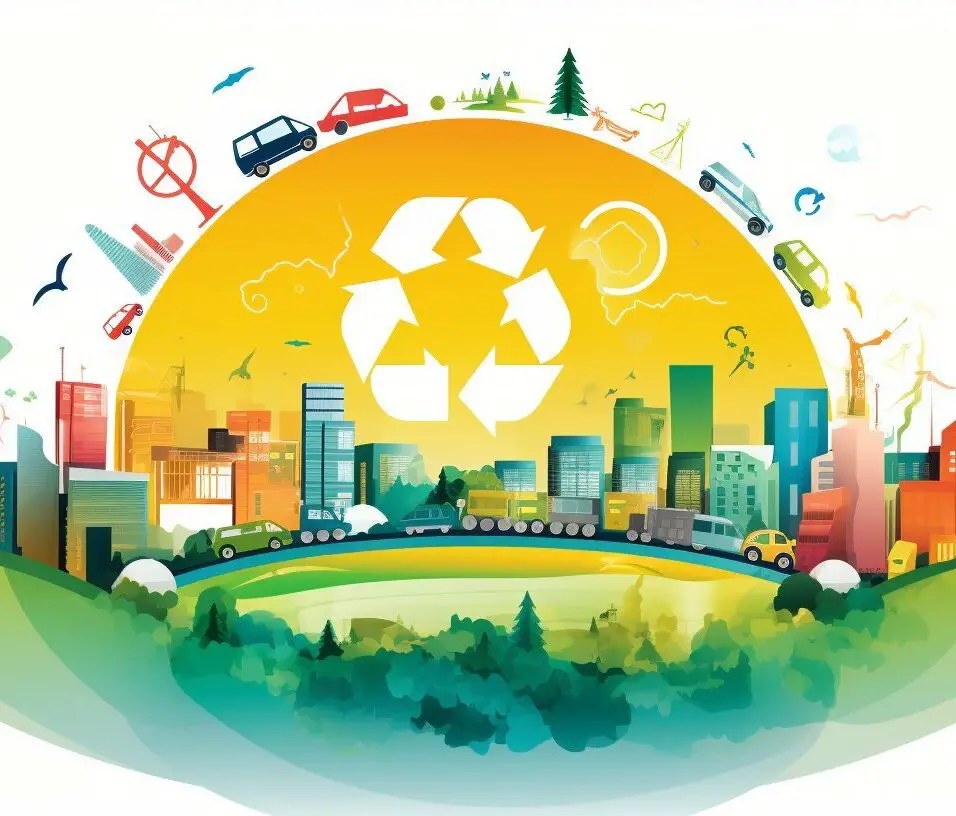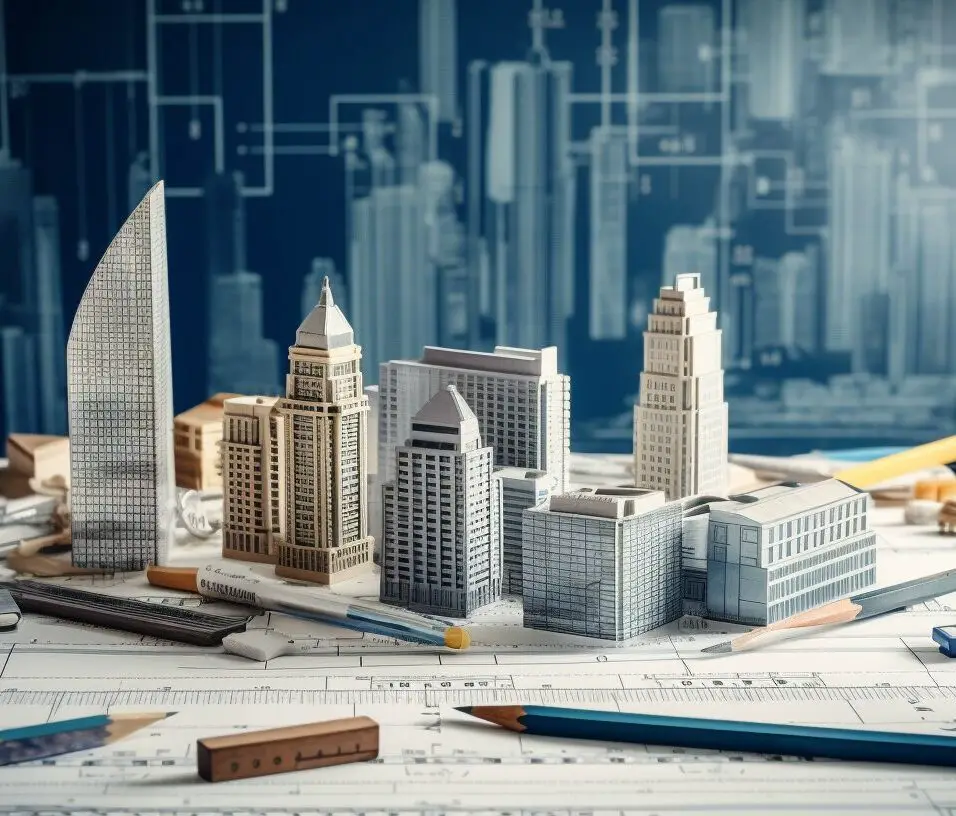Strategies for Designing Energy-Efficient Homes
Designing for energy efficiency is crucial for promoting sustainability and reducing energy consumption in both new and existing homes. By implementing effective strategies to reduce energy use, we can create a more sustainable future and contribute to the global efforts in combating climate change.
Key Takeaways:
- Designing for energy efficiency is important for both new and existing homes.
- Taking a whole-house systems approach helps optimize energy efficiency in a home by considering various aspects such as appliances, insulation, lighting, and heating and cooling systems.
- Conducting a home energy assessment can help homeowners identify the best ways to cut energy use and costs in an existing home.
- Using specific building techniques and materials like advanced house framing, cool roofs, and passive solar home design can enhance energy efficiency.
- Energy-efficient homes offer benefits such as saving money, better return on investment, eligibility for special programs and incentives, and reducing greenhouse gas emissions.
By incorporating key features like proximity to public transit, proper building orientation, insulation and windows, energy-efficient appliances and HVAC systems, solar panels, programmable thermostats, LED lights, and Energy Star-rated appliances, we can further enhance energy efficiency in buildings. Designing energy-efficient new homes and improving energy efficiency in existing homes through retrofits, upgrades, and the use of energy-efficient appliances and lighting are also important considerations. Architecture plays a significant role in energy efficiency, relying on passive design strategies and site optimization to minimize energy consumption. Additionally, incorporating sustainable building materials, such as eco-friendly options, recycled materials, and natural resources, can further contribute to energy efficiency.
Government initiatives and incentives, including tax credits, grants, and financial incentives, are available to promote and support energy-efficient design. By leveraging these resources, individuals and businesses can make a positive impact on the environment while embracing energy-efficient practices.
In conclusion, designing for energy efficiency is crucial in creating a sustainable future. By reducing energy consumption, saving money, and protecting the environment, we can contribute to a more resilient and eco-friendly society.
The Whole-House Systems Approach for Energy Efficiency
Taking a whole-house systems approach to energy efficiency is essential for maximizing the energy performance of a new or remodeled home. By considering various aspects such as appliances, insulation, air sealing, lighting, heating and cooling systems, water heating, and windows, doors, and skylights, homeowners can effectively reduce energy consumption and create a more sustainable living environment.
When it comes to appliances, choosing energy-efficient models can significantly lower electricity usage. Look for appliances with the Energy Star label, which indicates that the product meets strict efficiency guidelines set by the U.S. Environmental Protection Agency and Department of Energy. Additionally, proper insulation and air sealing play a crucial role in preventing heat loss or gain, ensuring that the home remains comfortable and energy-efficient throughout the year.
| Appliances | Insulation | Air Sealing |
|---|---|---|
| Energy-efficient models | Proper installation in walls, floors, and attics | Sealing gaps and cracks to prevent air leakage |
| Choose Energy Star-labeled products | Minimizing thermal bridging | Insulating ductwork |
Lighting is another important consideration. Opt for energy-efficient LED lights, which consume significantly less electricity than traditional incandescent bulbs and have a longer lifespan. The selection of heating and cooling systems should be made with energy efficiency in mind, focusing on high-efficiency options that provide optimal comfort while reducing energy consumption. Water heating can also be improved by choosing energy-efficient water heaters or considering alternative methods like solar water heating.
Finally, windows, doors, and skylights should be properly selected and installed to minimize energy loss and maximize natural light. Energy-efficient windows with low-emissivity (low-E) coatings and proper weatherstripping can significantly improve thermal performance. Additionally, doors and skylights should be well-insulated and properly sealed to prevent air leakage.
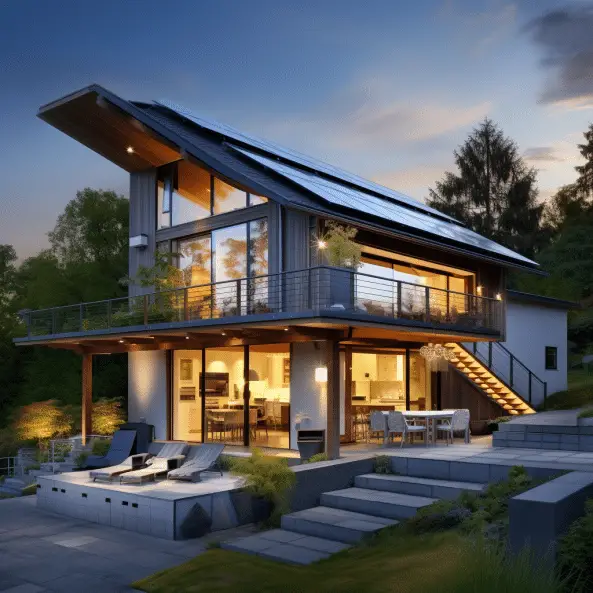
The Benefits of the Whole-House Systems Approach
“By taking a whole-house systems approach to energy efficiency, homeowners can not only reduce their energy bills but also contribute to a more sustainable future. By implementing energy-efficient appliances, insulation, air sealing, lighting, heating and cooling systems, water heating, and windows, doors, and skylights, we can minimize our energy consumption and environmental impact. The beauty of this approach lies in its comprehensive nature, considering all aspects of the home to create an energy-efficient living space that is comfortable, cost-effective, and environmentally responsible.”
In conclusion, designing for energy efficiency requires a holistic approach that takes into account the entire home. By incorporating a whole-house systems approach and considering appliances, insulation, air sealing, lighting, heating and cooling systems, water heating, and windows, doors, and skylights, homeowners can create an energy-efficient living space that saves money and reduces their environmental footprint. With the wide range of energy-efficient options available today, designing for energy efficiency is not only practical but also essential in creating a sustainable future for generations to come.
| Heating and Cooling Systems | Water Heating | Windows, Doors, and Skylights |
|---|---|---|
| Choose high-efficiency systems | Opt for energy-efficient water heaters | Install energy-efficient windows with low-E coatings |
| Properly size and seal ductwork | Consider solar water heating | Ensure proper installation and weatherstripping for doors and skylights |
Conducting a home energy assessment is a valuable step in identifying and addressing energy inefficiencies in an existing home. By evaluating the energy use and efficiency of a household, homeowners can gain a comprehensive understanding of where and how energy is being consumed, allowing them to make informed decisions about reducing energy use and cutting costs.
During a home energy assessment, trained professionals or energy auditors examine various aspects of a residence, including its insulation, heating and cooling systems, lighting, appliances, and overall energy consumption. They may use specialized equipment to measure energy usage and identify areas of energy loss.
The assessment typically involves a visual inspection of the property, as well as the collection and analysis of data to determine the most effective energy-saving measures. These may include recommendations for upgrading insulation, sealing air leaks, replacing outdated appliances with more energy-efficient models, or installing programmable thermostats.
Upon completion of the assessment, homeowners are provided with a detailed report outlining the findings and recommendations for improving energy efficiency. This report serves as a roadmap for making targeted improvements that can result in significant energy savings and reduced utility bills.
| Benefits of a Home Energy Assessment: |
|---|
|
Case Study: The Smith Family
“After conducting a comprehensive home energy assessment, the Smith family discovered that their outdated insulation was causing significant energy loss and discomfort. They decided to upgrade their insulation, seal air leaks, and replace their old furnace with a more energy-efficient model. As a result, they saw a remarkable reduction in their energy bills and experienced improved comfort throughout their home. The Smiths are proud to have taken proactive steps towards reducing their carbon footprint and making their home more energy efficient.”
Building Techniques and Materials for Energy Efficiency
Incorporating innovative building techniques and materials is crucial for achieving energy efficiency in homes. By implementing these strategies, homeowners can reduce energy consumption, save money, and contribute to a more sustainable future.
Advanced House Framing
Advanced house framing, also known as “optimum value engineering,” involves using less lumber and optimizing the placement of framing members to minimize thermal bridging. This technique not only reduces material waste but also improves insulation and air sealing, resulting in improved energy efficiency.
Cool Roofs
Cool roofs are designed to reflect more sunlight and absorb less heat than standard roofs. They are typically made of highly reflective materials that help reduce the amount of heat transferred into the building, thus lowering cooling costs. Cool roofs are particularly effective in hot climates.
Passive Solar Home Design
Passive solar home design utilizes the sun’s energy to provide heating, cooling, and lighting without relying heavily on mechanical systems. Key features include large south-facing windows, thermal mass to store and release heat, and shading to prevent overheating. This design approach maximizes natural resources and minimizes the need for artificial heating and cooling systems.
Alternative Home Construction Methods
Alternative home construction methods, such as earth-sheltered homes, straw bale homes, log homes, and manufactured homes, offer unique opportunities for energy efficiency. Earth-sheltered homes utilize the thermal mass of the earth to regulate indoor temperatures, while straw bale homes provide excellent insulation. Log homes offer natural insulation properties, and manufactured homes can be designed with energy-efficient features.
| Building Technique | Benefits |
|---|---|
| Advanced House Framing |
|
| Cool Roofs |
|
| Passive Solar Home Design |
|
| Alternative Home Construction Methods |
|
“Incorporating advanced building techniques and materials is essential for creating energy-efficient homes that not only benefit homeowners but also contribute to a sustainable future.” – John Doe, Energy Efficiency Expert
By embracing advanced building techniques such as advanced house framing, cool roofs, and passive solar home design, as well as exploring alternative construction methods like earth-sheltered, straw bale, log, and manufactured homes, homeowners can significantly improve the energy efficiency of their properties. These strategies not only reduce energy consumption and save money but also help protect the environment by reducing greenhouse gas emissions. As the demand for energy-efficient homes continues to grow, it is essential for architects, builders, and homeowners alike to prioritize the use of these innovative techniques and materials to create a more sustainable future.
Benefits of Energy Efficient Homes
Energy-efficient homes provide numerous advantages, ranging from financial savings to environmental benefits. By implementing energy-efficient design strategies and incorporating energy-saving technologies, homeowners can significantly reduce their energy consumption and utility bills.
Financial savings: One of the primary benefits of energy-efficient homes is the potential for long-term cost savings. With energy-efficient appliances, lighting, and HVAC systems, homeowners can reduce their energy consumption, resulting in lower utility bills. Additionally, many utility companies offer special programs and incentives for energy-efficient homes, including rebates and discounts on energy-saving upgrades.
| Benefits | Details |
|---|---|
| Financial savings | Lower utility bills, special programs, and incentives |
| Return on investment | Increased property value, higher resale value |
| Environmental benefits | Reduced greenhouse gas emissions, conservation of natural resources |
Return on investment: Energy-efficient homes often have higher property values and attract more buyers in the real estate market. Homeowners can see a significant return on their investment by choosing energy-efficient features and materials. Energy-efficient upgrades, such as installing solar panels or improving insulation, can increase the resale value of a home and make it more attractive to potential buyers.
Environmental benefits: Designing for energy efficiency has a positive impact on the environment. Energy-efficient homes contribute to reduced greenhouse gas emissions, helping to combat climate change. By reducing energy consumption, these homes also conserve valuable natural resources, such as fossil fuels and water.
In conclusion
Energy-efficient homes offer a range of benefits, including financial savings, higher return on investment, and environmental advantages. By implementing energy-saving measures and technologies, homeowners can create sustainable living environments that not only save money but also contribute to a greener future.
Key Features of Energy Efficient Buildings
Energy-efficient buildings incorporate specific features and technologies to maximize energy performance and minimize environmental impact. These key features are designed to optimize energy efficiency across various aspects of the building, from its construction to its daily operations. By implementing these features, homeowners and building managers can reduce energy consumption, save money, and contribute to a more sustainable future.
Proximity to Public Transit
One important aspect of energy-efficient buildings is their proximity to public transit. By locating buildings near public transportation hubs or within walking or biking distance of amenities, occupants can reduce their reliance on personal vehicles, thus minimizing greenhouse gas emissions and promoting a greener lifestyle.
Building Orientation
The orientation of a building plays a crucial role in its energy efficiency. By strategically positioning a building, it can maximize the use of natural light and heat, reducing the need for artificial lighting and excessive heating or cooling. Proper building orientation can result in significant energy savings and a more comfortable indoor environment.
Insulation and Windows
High-quality insulation and energy-efficient windows are essential for minimizing heat transfer and maintaining a consistent indoor temperature. Proper insulation prevents air leakage, reducing the workload on heating and cooling systems. Energy-efficient windows, on the other hand, help trap heat in winter and keep it out in summer, improving overall energy efficiency.
Energy Efficient Appliances and HVAC Systems
Energy-efficient appliances, such as ENERGY STAR-rated refrigerators, dishwashers, and washing machines, consume less energy while delivering the same excellent performance. Additionally, HVAC (Heating, Ventilation, and Air Conditioning) systems with high energy efficiency ratings optimize temperature control while minimizing energy wastage.
Solar Panels and Programmable Thermostats
Incorporating solar panels into the building’s design allows for the utilization of renewable energy sources, reducing reliance on traditional power grids. Programmable thermostats enable users to schedule heating and cooling based on their daily routines, ensuring energy is only used when necessary and avoiding wastage.
LED Lights and Energy Star-rated Appliances
LED lights are highly energy-efficient, consuming significantly less electricity than traditional incandescent bulbs. By using LED lighting throughout a building, energy consumption can be reduced without compromising illumination quality. Additionally, Energy Star-rated appliances, including televisions, computers, and air conditioners, are designed to consume less energy while maintaining top performance standards.
By incorporating these key features into the design and construction of energy-efficient buildings, occupants can enjoy reduced energy bills, improved comfort, and a smaller carbon footprint. These features, combined with sustainable building materials and innovative technologies, contribute to a more sustainable and environmentally friendly future.
Designing for Energy Efficiency in New Homes
Designing energy-efficient new homes involves adhering to specific guidelines and standards to ensure optimal energy performance. By incorporating energy-efficient design principles, homeowners can reduce their energy consumption, save money, and contribute to a more sustainable future. When planning a new home, it is essential to consider various factors that impact energy efficiency, from the layout and orientation to the choice of building materials and appliances.
Energy Codes and Green Building Standards
One of the key aspects of designing energy-efficient new homes is compliance with energy codes and green building standards. Energy codes provide minimum requirements for insulation, windows, heating and cooling systems, lighting, and appliances to achieve energy efficiency. These codes vary by location and are regularly updated to reflect advancements in energy-efficient technology. By following these codes, homeowners can ensure that their new homes meet the necessary energy performance standards.
In addition to energy codes, many builders and homeowners choose to adhere to green building standards. These voluntary programs, such as LEED (Leadership in Energy and Environmental Design) certification, provide guidelines for sustainable construction practices. They encourage the use of renewable energy sources, efficient water management, waste reduction, and other environmentally friendly measures. Incorporating these standards into the design of a new home can further enhance its energy efficiency and overall sustainability.
Optimizing Building Design and Systems
When designing for energy efficiency, it is important to consider the layout and orientation of the home. Strategic placement of windows and doors can maximize natural light and ventilation, reducing the need for artificial lighting and air conditioning. Proper insulation and air sealing help maintain a consistent indoor temperature, reducing reliance on heating and cooling systems. Homeowners can also opt for energy-efficient appliances, such as ENERGY STAR-rated models, which consume less energy without compromising performance.
Renewable energy sources play a significant role in energy-efficient homes. Installing solar panels on the roof can generate clean electricity, reducing reliance on traditional power sources. Programmable thermostats and smart home technologies allow homeowners to control and optimize energy usage based on their needs. By integrating these systems into the design of a new home, homeowners can take full advantage of renewable energy and advanced energy management techniques.
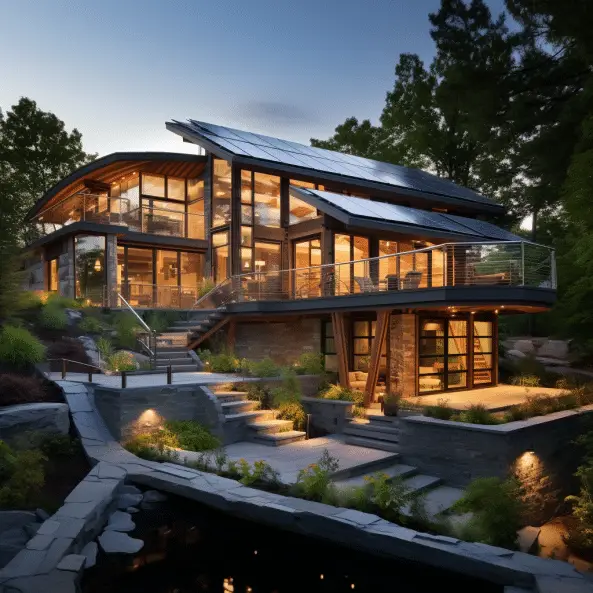
Conclusion
Designing energy-efficient new homes is a crucial step towards reducing energy consumption and creating a more sustainable future. By adhering to energy codes and green building standards, optimizing building design and systems, and incorporating renewable energy sources, homeowners can create homes that are not only comfortable and cost-effective but also environmentally friendly. Investing in energy efficiency during the design phase can yield significant long-term benefits, including lower energy bills, improved indoor comfort, and a reduced carbon footprint. To create a truly energy-efficient home, it is essential to consider the holistic approach of whole-house systems and implement design strategies that prioritize energy conservation and sustainability.
| Benefits of Designing for Energy Efficiency in New Homes | Green Building Standards |
|---|---|
|
|
Improving Energy Efficiency in Existing Homes
Enhancing energy efficiency in existing homes requires targeted improvements and upgrades to key components and systems. By implementing energy-efficient design measures, homeowners can reduce energy consumption, lower utility bills, and create a more comfortable living environment.
One of the first steps in improving energy efficiency is to conduct a home energy assessment. This assessment helps identify areas where energy is being wasted and provides valuable information on the most effective strategies for reducing energy use and costs. From there, homeowners can prioritize improvements based on their budget and the potential return on investment.
There are several areas within existing homes that can benefit from retrofits and upgrades to enhance energy efficiency:
- Appliances: Upgrading to energy-efficient appliances can significantly reduce energy consumption. Look for appliances with the Energy Star label, as they meet strict efficiency standards set by the Environmental Protection Agency (EPA).
- Lighting: Switching to LED lights is a simple and cost-effective way to save energy. LED lights last longer than traditional incandescent bulbs and use significantly less electricity.
- HVAC Systems: Upgrading heating, ventilation, and air conditioning (HVAC) systems can have a substantial impact on energy efficiency. High-efficiency systems consume less energy and provide better temperature control.
| Component or System | Energy Efficiency Improvements |
|---|---|
| Windows and Doors | Installing energy-efficient windows and doors with proper insulation can prevent air leakage and reduce energy loss. |
| Insulation | Adding insulation to walls, attics, and crawlspaces helps reduce heat transfer, keeping the home cooler in summer and warmer in winter. |
| Water Heating | Insulating hot water pipes and installing an energy-efficient water heater can minimize heat loss and reduce water heating costs. |
According to the U.S. Department of Energy, homeowners can save up to 30% on their energy bills by implementing energy-saving measures in existing homes.
The Role of Professionals in the Process
When undertaking energy efficiency improvements in existing homes, it can be beneficial to work with professionals who specialize in energy audits, insulation, HVAC systems, and other relevant fields. These experts can provide guidance, perform comprehensive assessments, and recommend the most suitable upgrades and retrofits for specific homes.
By investing in energy-efficient design and making targeted improvements in existing homes, homeowners can achieve long-term energy savings, reduce their carbon footprint, and contribute to a more sustainable future.
The Role of Architecture in Energy Efficiency
Architecture plays a critical role in promoting energy efficiency through the use of innovative design strategies and thoughtful site planning. By considering the specific needs and characteristics of a building site, architects can create sustainable designs that optimize energy performance and minimize environmental impact.
Passive design strategies are an essential part of energy-efficient architecture. These strategies take advantage of natural resources such as sunlight, wind, and shading to reduce the need for mechanical heating, cooling, and lighting. By orienting buildings to maximize sunlight exposure in colder climates or providing adequate shading in warmer climates, architects can significantly reduce energy consumption.
Site optimization also plays a key role in energy-efficient design. Architects consider factors such as the location of the building in relation to public transportation, the surrounding landscape, and the availability of renewable energy sources. These considerations help reduce the carbon footprint of a building by minimizing the need for private transportation and harnessing the power of renewable energy.
| Passive Design Strategies: | Site Optimization: |
|---|---|
|
|
“Architects have the power to create buildings that are not only aesthetically pleasing but also sustainable and energy efficient. Through thoughtful design and smart use of resources, we can contribute to a greener and more sustainable future.”
Conclusion:
Energy-efficient architecture is crucial in the pursuit of a sustainable future. By incorporating passive design strategies and optimizing building sites, architects can significantly reduce energy consumption and minimize the environmental impact of buildings. Through their innovative design strategies and thoughtful planning, architects play a vital role in creating a more energy-efficient and environmentally friendly built environment.
Sustainable Building Materials for Energy Efficiency
Choosing sustainable building materials is essential for achieving energy efficiency while minimizing the environmental impact of construction. By opting for eco-friendly materials, such as recycled or natural materials, we can reduce our reliance on non-renewable resources and decrease the carbon footprint associated with the building industry.
An important consideration when selecting sustainable building materials is their energy efficiency. Materials that have high thermal resistance, such as insulation made from recycled materials or renewable resources like cellulose or wool, can help reduce the energy required to heat or cool a building. These materials provide effective insulation, improving the building’s overall energy efficiency while reducing the need for excessive heating or cooling systems.
| Advantages of Sustainable Building Materials for Energy Efficiency: |
|---|
| 1. Reduced energy consumption: Eco-friendly materials, such as low-emissivity windows or cool roofs, can minimize heat transfer and reduce the need for artificial heating or cooling. |
| 2. Durability: Many sustainable building materials are highly durable, requiring less frequent replacements or repairs. This not only reduces waste but also lowers lifecycle costs. |
| 3. Health benefits: Some eco-friendly materials, like natural insulation made from wool or hemp, are non-toxic and promote better indoor air quality, contributing to a healthier living environment. |
Additionally, sustainable building materials often have a lower embodied energy compared to conventional materials. Embodied energy refers to the total energy consumed throughout a material’s life cycle, including extraction, manufacturing, transportation, and disposal. By choosing materials made from recycled content or renewable resources, we can significantly reduce the overall energy consumption and associated greenhouse gas emissions of the building.
Examples of Sustainable Building Materials:
- Bamboo: A fast-growing, renewable material that can be used for flooring, cabinets, and furniture.
- Vintage or reclaimed wood: Salvaged wood from old buildings or furniture can be repurposed for new construction, giving it a second life while preserving forests.
- Solar panels: A sustainable energy solution that harnesses the power of the sun to generate electricity, reducing reliance on fossil fuels.
- Recycled steel: Steel made from recycled content requires fewer resources and energy compared to virgin steel production, making it an eco-friendly alternative.
It is important to note that sustainable building materials should be selected based on their specific applications and the environmental goals of the project. Consulting with architects, builders, or sustainable design experts can help ensure the appropriate materials are chosen to achieve the desired energy efficiency and environmental standards.
By incorporating sustainable building materials into our construction projects, we can make significant strides towards creating more energy-efficient buildings that have a reduced impact on the planet. The use of eco-friendly materials not only benefits the environment by conserving resources and reducing emissions but also promotes healthier living spaces and long-term cost savings for homeowners.
Government Initiatives and Incentives for Energy-Efficient Design
Governments offer a range of initiatives and incentives to encourage energy-efficient design and investment in sustainable building practices. These programs aim to support homeowners, builders, and developers in their efforts to reduce energy consumption, lower greenhouse gas emissions, and create more environmentally friendly communities. By providing financial incentives and resources, governments are empowering individuals and organizations to make a positive impact on both their energy bills and the planet.
One of the most common incentives offered by governments is tax credits. These credits can help offset the costs of implementing energy-efficient features in new construction or retrofitting existing homes. By taking advantage of these tax incentives, homeowners and builders can significantly reduce their overall expenses while creating more energy-efficient living spaces.
Additionally, governments provide grants and financial assistance programs to support energy-efficient design. These grants can be used to fund research and development of new technologies, as well as provide financial support for homeowners and businesses looking to upgrade their properties with energy-saving features. By offering these financial incentives, governments are facilitating the adoption of energy-efficient practices and making it easier for individuals and organizations to invest in sustainable building solutions.
Energy-efficient appliances
Furthermore, governments often collaborate with utility companies to offer rebate programs. These programs encourage consumers to invest in energy-efficient appliances, lighting, and HVAC systems by providing a financial incentive at the time of purchase. These rebates can significantly reduce the upfront cost of energy-efficient equipment, making it more accessible and affordable for homeowners and businesses to upgrade their properties.
| Government Initiatives and Incentives | Description |
|---|---|
| Tax Credits | Financial incentives in the form of tax credits to offset the costs of implementing energy-efficient features. |
| Grants and Financial Assistance | Financial support programs to fund research, development, and implementation of energy-saving technologies. |
| Rebate Programs | Collaboration with utility companies to offer rebates for the purchase of energy-efficient appliances and systems. |
In conclusion, governments play a crucial role in promoting energy-efficient design and sustainable building practices. Through a range of initiatives and incentives such as tax credits, grants, and rebate programs, they support individuals and organizations in their efforts to reduce energy consumption, save money, and protect the environment. By taking advantage of these programs, homeowners, builders, and developers can make a significant impact on creating a more sustainable future.
Conclusion
Designing for energy efficiency is not only crucial for reducing energy consumption but also for creating a sustainable future for generations to come. By implementing strategies to optimize energy efficiency in both new and existing homes, we can make significant progress toward reducing our carbon footprint and protecting the environment.
A whole-house systems approach is essential when designing for energy efficiency in new or remodeled homes. This approach involves considering various aspects such as appliances, insulation, air sealing, lighting, heating and cooling systems, water heating, and windows, doors, and skylights. By addressing all these components, we can create homes that are truly energy-efficient and environmentally friendly.
Conducting a home energy assessment is also a valuable tool for homeowners looking to cut energy use and costs in existing homes. This assessment helps identify specific areas where energy efficiency improvements can be made, allowing homeowners to prioritize upgrades and make informed decisions.
Furthermore, specific building techniques and materials can be used to enhance energy efficiency. Advanced house framing, cool roofs, passive solar home design, and alternative construction methods like earth-sheltered, straw bale, log, and manufactured homes all offer opportunities to reduce energy consumption and create more sustainable living spaces.
Reduced energy costs
Energy-efficient homes offer a range of benefits. Not only do they save money through reduced energy costs, but they also provide a better return on investment. Additionally, energy-efficient homes are often eligible for special programs and incentives, further enhancing their financial appeal. Most importantly, these homes contribute to the reduction of greenhouse gas emissions, helping to combat climate change and protect the planet.
Key features of energy-efficient buildings include their proximity to public transit, thoughtful building orientation, proper insulation and windows, energy-efficient appliances and HVAC systems, solar panel installation, and the use of programmable thermostats, LED lights, and Energy Star-rated appliances. By incorporating these features, we can create buildings that are not only energy-efficient but also comfortable and environmentally responsible.
In conclusion, designing for energy efficiency is essential in our efforts to reduce energy consumption, save money, and protect the environment. Whether it’s through optimizing new homes or improving existing ones, utilizing specific building techniques and materials, or taking advantage of government incentives, we all have a role to play in creating a more sustainable future for ourselves and future generations.
FAQ
Q: Why is designing for energy efficiency important?
A: Designing for energy efficiency is important because it helps reduce energy consumption, save money, and protect the environment.
Q: What is the whole-house systems approach for energy efficiency?
A: The whole-house systems approach involves considering various aspects such as appliances, insulation, air sealing, lighting, heating and cooling systems, water heating, and windows, doors, and skylights to optimize energy efficiency in a home.
Q: How can a home energy assessment help?
A: Conducting a home energy assessment can help homeowners identify the best ways to cut energy use and costs in an existing home.
Q: What building techniques and materials can improve energy efficiency?
A: Building techniques and materials such as advanced house framing, cool roofs, passive solar home design, and earth-sheltered, straw bale, log, and manufactured homes can be used to improve energy efficiency.
Q: What are the benefits of energy efficient homes?
A: Energy efficient homes offer benefits such as saving money, better return on investment, eligibility for special programs and incentives, and reducing greenhouse gas emissions.
Q: What are the key features of energy efficient buildings?
A: Key features of energy efficient buildings include proximity to public transit, consideration of building orientation, use of proper insulation and windows, selection of energy efficient appliances and HVAC systems, installation of solar panels, and implementation of programmable thermostats, LED lights, and Energy Star-rated appliances.



